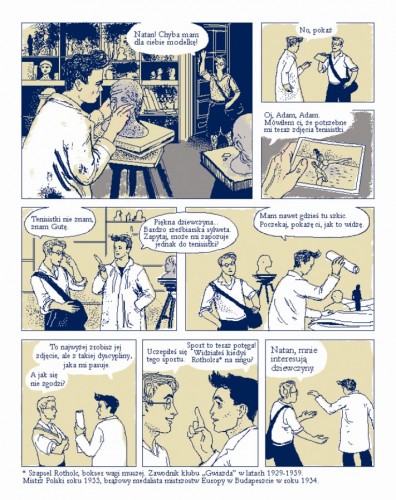 „Złote pszczoły. Żydzi międzywojennej Warszawy. Antologia komiksów”. Tekst Monika Powalisz, rysunki: Anna Czarnota, Zofia Dzierżawska, Joanna Jurczak, Malwina Konopacka, Agata „Endo” Nowicka, Olga Wróbel; Gmina Wyznaniowa Żydowska w Warszawie, 2011
„Złote pszczoły. Żydzi międzywojennej Warszawy. Antologia komiksów”. Tekst Monika Powalisz, rysunki: Anna Czarnota, Zofia Dzierżawska, Joanna Jurczak, Malwina Konopacka, Agata „Endo” Nowicka, Olga Wróbel; Gmina Wyznaniowa Żydowska w Warszawie, 2011
 „ZŁOTE PSZCZOŁY. ŻYDZI MIĘDZYWOJENNEJ WARSZAWY. ANTOLOGIA KOMIKSÓW”
„ZŁOTE PSZCZOŁY. ŻYDZI MIĘDZYWOJENNEJ WARSZAWY. ANTOLOGIA KOMIKSÓW”
JOANNA OSTROWSKA
„Złote pszczoły” można potraktować jako komiksowy bibelot. Rzeczywiście, na pierwszy rzut oka uwodzi czytelnika, ale ostatecznie pozostawia niedosyt.
.
Komiks historyczny brzmi dumnie, szczególnie jeśli przedstawiana w nim przeszłość dotyczy tematów żydowskich, holocaustowych, czy też „drugowojennych”. Gdyby nie medialna awantura z 2001 roku dotycząca klasycznego już „Mausa” Arta Spiegelmana, komiks jako forma zapisu doświadczenia przeszłości byłby prawdopodobnie szerzej nierozpoznany. Wojny o „polską twarz” i „świński rodowód” w „Mausie”, czy też standardowe do dziś przepychanki dotyczące „złych Polaków”, którzy muszą być zrównoważeni przedstawieniami tych „dobrych” – były tylko początkiem wielkiej batalii o pamięć.
Kilka lat później, w 2009 roku, Wydawnictwo K&L Press we współpracy z Muzeum Auschwitz-Birkenau rozpoczęło projekt pod tytułem „Epizody z Auschwitz”. Seria komiksów historycznych opartych na relacjach byłych więźniów kompleksu obozowego Auschwitz-Birkenau miała być pomocna przede wszystkim w edukacji młodych ludzi. Kluczowi bohaterowie tej serii to oczywiście postaci znane: Mala Zimetbaum i Edek Galiński, ojciec Maksymilian Kolbe, oraz Witold Pilecki. Wszystko w duchu narracji patriotycznej, oczywiście wbrew „szkodliwym stereotypom” i „ideologicznemu zacietrzewieniu”.
Antologia komiksów autorstwa Moniki Powalisz i sześciu rysowniczek to kolejna próba zmierzenia się z formą komiksu historycznego. Jako autorka scenariuszy wszystkich sześciu historii Powalisz zdecydowała się skoncentrować na wybranych biografiach osób żydowskiego pochodzenia, które były związane z Warszawą dwudziestolecia międzywojennego. Wszystko w duchu odzyskiwania żydowskiej przeszłości przedwojennej, która została całkowicie „zawłaszczona” przez pamięć Zagłady.
Każdy z komiksów narysowała inna rysowniczka. Dobór biografii bohaterów/bohaterek do autorek rysunków był prawdopodobnie czysto losowy. Obok „bywalczyni warszawskich salonów”, Izabeli Stachowicz „Czajki”, wśród komiksowych postaci mamy m.in.: warszawskich architektów Gelbarda i Sigalina, wydawcę Jakóba Mortkowicza, czy rzeźbiarza Natana Rapaporta. Odzyskane i narysowane historie to przede wszystkim epizody, krótkie impresje. W przypadku Ity Kalisz, córki otwockiego cadyka Mendla Kalisza, komiks koncentruje się dosłownie na pojedynczym wydarzeniu w jej życiu – śmierci ojca (tytułowe „Złote pszczoły”). Podobnie została przedstawiona historia Guty Berliner, zawodniczki „Maccabi Warszawa”, która pozowała Adamowi Rubinowi i pośrednio również Natanowi Rapaportowi w jego pracowni rzeźby („Dziewczyna z fotografii”).
„Złote pszczoły” można potraktować jako komiksowy bibelot. Rzeczywiście na pierwszy rzut oka uwodzi czytelnika, ale ostatecznie pozostawia niedosyt. Świetnie przygotowane wydawnictwo, w którym – a to nie zdarza się często – oprócz przedmowy Belli Szwarcman-Czarnoty z odwołaniami do innych „żydowskich komiksów” – takich jak choćby „wizualna relacja” autorstwa berlińskiej Żydówki Charlotte Salomon („Leben? Oder Theater?”), czy serii „Wonder Woman” – znajduje się również tekst samej Powalisz, a także historyczne posłowie i bibliografia pomocna w tworzeniu scenariuszy. We wszystkich tych elementach dominuje jeden głos – przywracanie historii przedwojennych Żydów, które koniec końców, już w samych komiksach, zostaje ograniczone jedynie do wyżej wspomnianych pojedynczych impresji. Oczywiście „Złote pszczoły” mogłyby być początkiem serii, ale, niestety, prawdopodobnie nie jest to zamiarem autorek.
 rys. Agata Nowicka Endo
rys. Agata Nowicka Endo
Jeśli skonfrontować komiks Moniki Powalisz i jej rysowniczek z „Berlinem” Jasona Lutesa, niedosyt staje się wręcz nie do zniesienia. Oczywiście wizualna historia ostatnich lat Republiki Weimarskiej to jeden z najlepszych anglojęzycznych komiksów na świecie (zgodnie z listą tygodnika „Time” z 2005 roku), ale mimo wszystko warto go w tym przypadku przywołać. Już pierwszy tom „Berlin. Miasto z kamienia”, który składa się z ośmiu rozdziałów, to historia przeplatających się losów kilku bohaterów różnych opcji politycznych, różnego pochodzenia, z różnym życiowym doświadczeniem. Fabuła pierwszej części kończy się masakrą robotników 1 maja 1929 roku, która staje się punktem wyjścia dla kolejnej części. Społeczeństwo niemieckie wyłaniające się z komiksu Lutesa to skomplikowany twór, w którym tożsamości religijnej i narodowej, ideologii, czy klasy społecznej nie można zamknąć w naiwnym „obrazku” antysemickiego odrzucenia.
W przypadku „Złotych pszczół”, mimo mocnych deklaracji pokazania „różnorodności” żydowskiego świata dwudziestolecia międzywojennego, mamy do czynienia jedynie ze zbiorem luźno połączonych epizodów. Podobnie jak w książkach dla dzieci przekonują one, że Żydzi istnieli, przyjaźnili się z polskimi twórcami kultury, byli narażeni na antysemityzm i czasami udawało im się wyjechać do „Ziemi Świętej”.
„Złote pszczoły”, stworzone w szczytnym celu „przypominania”, stanowią jedynie punkt wyjścia dla większej narracji, która mogłaby mieć podtytuł: „Żydzi Międzywojennej Warszawy”.
Zawartość publikowanych artykułów i materiałów nie reprezentuje poglądów ani opinii Reunion’68,
ani też webmastera Blogu Reunion’68, chyba ze jest to wyraźnie zaznaczone.
Twoje uwagi, linki, własne artykuły lub wiadomości prześlij na adres:
webmaster@reunion68.com




